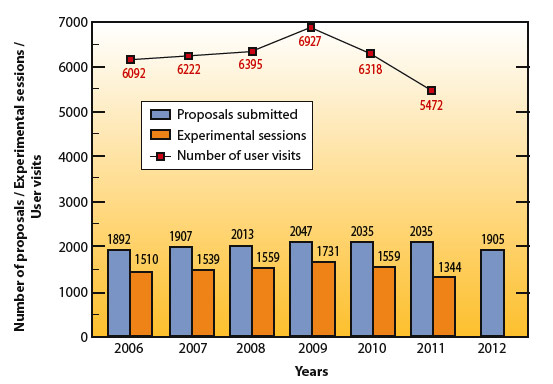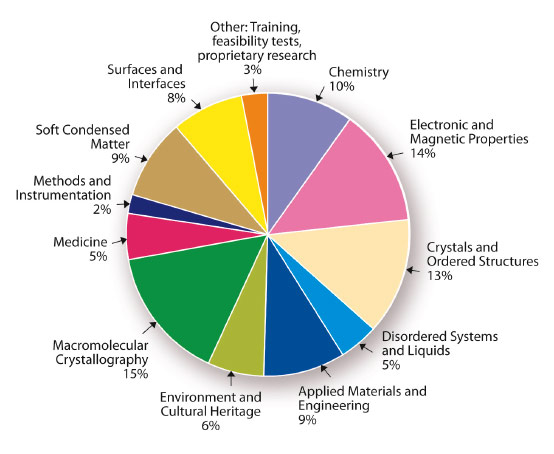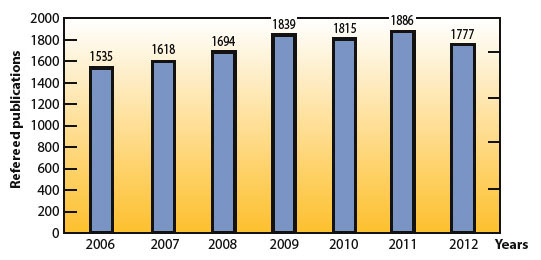User operation
User operation of the facility for the year 2012 began after the first ever “long shutdown” since ESRF opened its beamlines to users in 1994. Following eighteen years of successful operation, the ESRF accelerator and beamlines were shut down on Monday 5th December 2011 for a 5-month period, during which time the construction works for the new EX2 experimental hall extension began. The accelerator and beamlines were restarted on schedule in early May 2012, and user operation resumed on 9th May 2012. The total beam time available for 2012 was reduced by 30% compared with a year of standard operation.
Major changes to the beamline portfolio have taken place through the Upgrade Programme: the EXAFS beamline ID24 was re-opened, beamlines ID10A/B/C were rebuilt as one beamline complex ID10, beamline ID16 was closed and the upgrade beamline is being rebuilt on ID20, and the Bio-SAXS beamline ID14-3 was moved to BM29. Beamline ID32 had to be closed to accommodate the upgrade beamline project UPBL7 following restrictions to the ESRF budget. In total, 28.25 ESRF publicly funded beamlines and 9 CRG beamlines were available for users in 2012. Figure 156 shows the number of applications for beam time received since 2006. Since the beginning of the Upgrade Programme works in 2010, the number of applications received has evened off due to the unavailability of those beamlines undergoing upgrade and the closure of others. The small drop (6%) in the number of proposals received for 2012 was an expected consequence of the long shutdown. But this can also be attributed to the reduction in the number of beamlines available to users, down by more than 10% over the last 2 years (28.25 ESRF beamlines and 9 CRG beamlines in 2012 compared with 32 public and 10 CRG beamlines in 2010). Despite this, there has been very little decrease in the number of proposals received, while the number of proposals received per operating beamline continues to increase.
|
|
|
Fig. 156: Numbers of applications for beam time, experimental sessions and user visits, 2006 to 2012. N.B. Final numbers of experimental sessions and user visits for 2012 were not available at the time of going to press. |
Proposals for experiments are selected and beam time allocations are made through peer review. As in previous years, beam time for 2012 was allocated based on recommendations made by review committees of specialists, for the most part from European countries and Israel, set up in the following scientific areas:
- chemistry
- hard condensed matter: electronic and magnetic properties
- hard condensed matter: crystals and ordered systems
- hard condensed matter: disordered systems and liquids
- applied materials and engineering
- environmental and cultural heritage matters
- macromolecular crystallography
- medicine
- methods and instrumentation
- soft condensed matter
- surfaces and interfaces
The review committees met twice during the year, around six weeks after the deadlines for submission of proposals (1 September 2011 and 1 March 2012). They reviewed 1905 applications for beam time, and selected 719 (37.7%), which were then scheduled for experiments.
A new structure was put into place during 2012 for the proposal review process with the aim of allowing all proposals received for a particular beamline to be assessed by the same review committee. This gives the committees a better overall view of all the projects proposed for a single beamline, and allows them greater flexibility to optimise the selection of proposals awarded beam time on each beamline. Beamlines of similar techniques or activities were grouped together to form ten new review committees. This new structure was used for the first time during the September-October 2012 proposal round where beam time is allocated for the first half of 2013. Requests for beam time in 2012, which is scheduled in shifts of 8 hours, totalled 28 267 shifts or 226 136 hours, of which 9 932 shifts or 79 456 hours (35.1%) were allocated. The distribution of shifts requested and allocated, by scientific area, is shown in Table 7.
|
|
|
Table 7: Number of shifts of beam time requested and allocated for user experiments, year 2012. |
The breakdown of shifts scheduled for experiments by scientific area in the first half of 2012 is shown in Figure 157. This same period (less than 3 months of beam time) saw 2091 visits by scientists to the ESRF under the user programme, to carry out 491 experiments. Overall, the number of users in each experimental team averaged just over 4 persons as in all previous years, and the average duration of an experimental session was 9 shifts as in 2011. This can be further broken down to show an average duration of 3 shifts for MX experiments and just over 14 shifts for non-MX experiments. The annual number of experimental sessions and user visits since 2006 is shown in Figure 156. The particularly high figures in the full year 2009 are mainly due to the fact that an extra week of beam time was made available to users during that year to compensate partly for the anticipated reduction in beam time available in later years following the start of the reconstruction work of the Upgrade Programme. The effect of the reduction in beam time available in 2011 due to the long shutdown is clearly visible in the lower-than-normal numbers of experimental sessions carried out and user visits, and we expect similar numbers for 2012 once the 2012/II scheduling period finishes at the end of February 2013.
|
|
|
Fig. 157: Shifts scheduled for experiments, May to July 2012, by scientific area. |
One of the principle measurable output parameters of the ESRF is the number and quality of publications accepted in peer-reviewed journals. Figure 158 shows how this number has been rising continuously over the past years, with a publication output systematically on a level of over one publication per experimental session and reaching a record number of nearly 1900 for the year 2011. The year 2012 promises to be equally fruitful, with 1777 publications already registered in the ILL/ESRF Library database. Since ESRF began user operation back in 1994, a total of 21,294 publications have been accepted in peer-reviewed journals. Of these, more than 200 every year are published in high impact factor journals.
|
|
|
Fig. 158: Numbers of publications appearing in refereed journals reporting on data collected either partially or totally at ESRF, 2006 to 2012. |
User responses to questionnaires show once again that the ESRF continues to maintain its excellent reputation concerning the assistance and service given by scientists and support staff on beamlines, and travel and administrative arrangements, in addition to the quality both of the beam and of the experimental stations. Facilities on site, such as preparation laboratories, the Guesthouse and a canteen open 7 days a week, also make an important contribution to the quality of user support.







